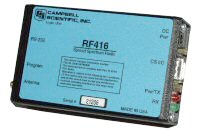
Overview
The RF416 has a 2.45- to 2.46-GHz frequency range, which is used in many countries worldwide. This 50-mW spread-spectrum radio can transmit data to another RF416 radio, an RF432 radio, a CR216(X) datalogger, or an AVW216 interface.
The RF416 supports point-to-point and point-to-multipoint communications. It can serve as a field modem/radio while connected to the datalogger or as a base station modem/radio while connected to a computer. The radio can also serve as a stand-alone RF router/repeater.
Read MoreBenefits and Features
- Long range, wireless communications between devices
- Hassle-free operation in many countries where license-free operation is allowed
- Low average power consumption
- Optimized for Campbell Scientific PakBus networking
- Improved RF efficiency when using PakBus protocol compared to other third-party solutions
- Low-cost, stand-alone operation when a dedicated PakBus RF repeater is needed
- Frequency hops over 25 channels avoid interference from other spread-spectrum radios
Images

Similar Products
Detailed Description
The RF416 reduces susceptibility to RF interference from other spread spectrum devices by providing user-selectable frequency hopping patterns. Spread spectrum radios spread the normally narrowband information signal over a relatively wide band of frequencies. This process allows communications to be more immune to noise and interference from RF sources such as pagers and cellular phones.
Compatibility
Please note: The following shows notable compatibility information. It is not a comprehensive list of all compatible products.
Additional Compatibility Information
Communications
Internal Radio of CR216(X) Dataloggers
The RF416 spread spectrum radio can communicate with the internal spread spectrum radio of our CR216(X) dataloggers. Certain RF416 settings must match the CR216(X) settings for communications between the radio and data logger to be successful. The factory default settings of these devices may not match; therefore, they may need to be reconfigured before communications can take place. For more information, refer to the Quick Reference Guide for Setting Up RF401-to-CR206 Communication application note (see Documents on the right).
Other Spread-Spectrum Radios
RF416 radios can be used in networks containing RF432 and RF415 radios. When RF416 radios are used in networks that include RF415 radios, the Protocol must be set to Transparent. Also, If RF415 and RF416 radios will be in the same RF proximity, do not use 28, 44, 52, 56, or 60 for the RF415 Net Address. RF415 radios with Net Addresses of 28, 44, 52, and 56 interfere with RF416 radios with Net Addresses of 0, 1, 2, and 3, respectively. The RF415 Net Address of 60 interferes with all RF416 Net Addresses.
The RF416's 2.4 GHz radio is also a good fit for parallel operation in RF450, 900 MHz networks due to the frequency difference (i.e., 2400 MHz versus 900 MHz).
Campbell Scientific does not recommend using the RF416 in networks containing FGR-115 radios.
Transparent and PakBus Protocols
Do not mix RF416 radios set to the Transparent protocol with RF416 or RF432 radios set to either of the PakBus protocols, since this will produce RF traffic without any RF communications. However radios with the PakBus Aware and PakBus Node settings can coexist in the same network (i.e., some radios set to PakBus Aware and some radios set to PakBus Node).
Enclosure Considerations
A desiccated, non-condensing environment is required. The 14162 Mounting Kit includes hardware for securing the RF416 to an enclosure backplate (see Ordering Info).
Specifications
| Frequency | 2.450 to 2.482 GHz |
| Radio Type | Frequency Hopping Spread Spectrum (FHSS) |
| Country Used In | Any country where 2.4 GHz Wi-Fi communications are allowed |
| Transmission Distance | 0.4 km (0.25 mi) with omnidirectional antenna (outdoors); up to 0.8 km (0.5 mi) with higher-gain directional antennas at ideal conditions |
| RS-232 Baud Rate | 38.4k, 19.2k, 9600, 4800, or 1200 bps |
| Channel Capacity | 65,000 Network Identifiers share 25 hop channels. |
| Frequency Hopping Patterns | 6 different selectable patterns |
| Frequency Control | Direct FM |
| Receiver Sensitivity | -104 dBm at 10-4 bit error rate (Campbell Scientific protocols will issue retries wherever a bit error occurs.) |
| Interference Rejection | 70 dB (at pager and cellular phone frequencies) |
| Power Output | 50 mW (nominal) |
| Data Rate | 10 kbps |
| Antenna Connector | Reverse Polarity SMA (RPSMA) |
| RS-232 Connector | 9-pin D female (4 wire: Tx, Rx, CTS, GND) |
| CS I/O Connector | 9-pin D male |
| FCC ID | OUR-24XSTREAM |
| Power | 9 to 16 Vdc |
| Operating Temperature Range | -25° to +50°C |
| LEDs | Power on, TX, RX, diagnostics |
| Power Connector | Barrel plug, center positive 12 V (used to connect the 14291 Field Power Cable) |
| Average Current Drain |
|
| Communication Ports |
|
| Dimensions | 11.4 x 7.0 x 2.9 cm (4.5 x 2.8 x 1.1 in.) |
| Weight | 227 g (8 oz) |
Documents
Downloads
RF401 Series OS v.04 (646 KB) 14-08-2008
Current RF401, RF411, RF416 firmware. Requires the Device Configuration Utility.
Frequently Asked Questions
Number of FAQs related to RF416: 1
-
Yes. The BMP5 Direct SDK can communicate with the data logger as long as two conditions are met:
- The communications link between the data logger and the computer is transparent.
- There are no excessive delays.
